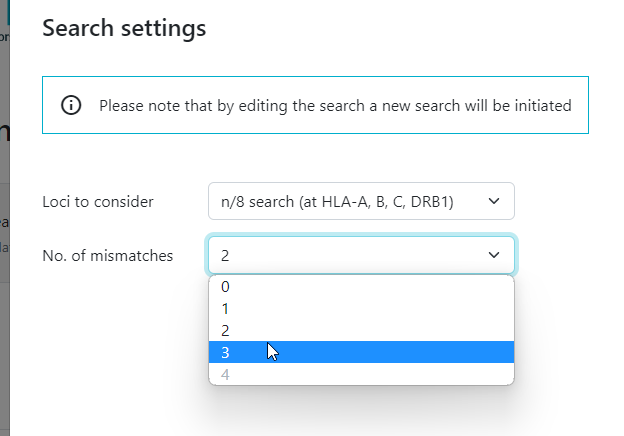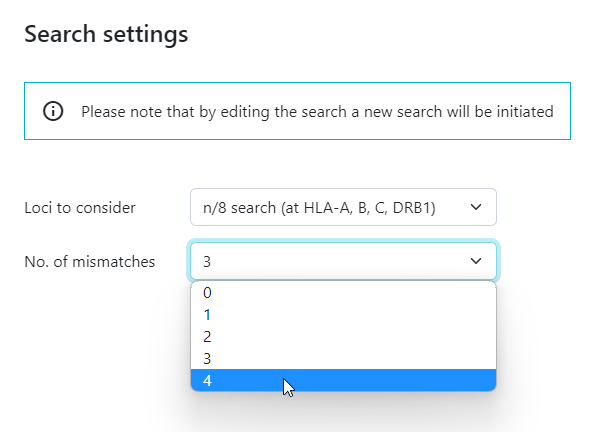...
The match list presents all possible options. In order to help search coordinators to select the best potential stem cell source, WMDA will be implementing an additional features to assist search coordinators, you can read the details below.
...
Three and four mismatch searches have been implemented for cord blood searches in Search & Match Service. This is a resource intensive service, therefore you first perform a two mismatch cord blood search before you start a three mismatch cord blood search:
- Step 1: run a two mismatch cord blood search, before you can start a three mismatch search
- Step 2: run a three mismatch cord blood search before you can start a four mismatch cord blood search
What is important to know about three and/or four mismatch searches?
In the old legacy version of Search & Match Service, no overall match probabilities calculations for cord blood were done. The sorting was performed within the match class (i.e. 5/8. 4/8) based on the Total Nucleated Cell (TNC) or CD34+ cell counts (depending on what a search coordinator prefers). This has been implemented in the same way in the new version of Search & Match Service operating with using the Hap-E matching algorithm.
In the new version of Search & Match Service the number of search results can be bigger, as the Hap-E matching algorithm returns more potential matched cord blood units. If you experience a high number of potential cord blood options, you can for example filter on the minimum TNC, minimum CD34+ or by selecting certain registries or mismatch locations.
...
Three and/or four mismatch cord blood search results do not have any match probabilities calculated, the results are currently sorted within their match class (e.g. 5/8, 4/8) only by TNC or CD34+. The Hap-E matching algorithm in the Search & Match Service returns more potential cord blood units than the legacy systemSearch & Match Service. Many of these “extra” cord blood units tend to be low probability cord blood optionsoptions to be selected for a patient in need of a transplant, because these cord blood units have low HLA resolution typing or missing allele typing.
...
"Score" based sorting for three and/or four mismatch cord blood results (see option 3 in above paragraph) - interim solution
In general it is true that the more highly typed a CBU/ donor on a match list isIt is common practice that the better HLA-typed stem cell source (donor/cord blood), the higher the probability of a potential match. As we are WMDA is currently not able to provide match probabilities and it will take a few months to fully develop, we will use a on cord blood searches, WMDA will be implementing an interim score based approach. This works in the following wayFind below the explanation:
- Assign a score based on the typed loci and their the resolution of the cord blood unit
- Each locus can have one of the following “resolutions”
- High resolution typing (only one ARD)
- Low or intermediate typing
- No typing
- Each resolution class per locus has a “score”.
- High resolution typing = 20
- Low or intermediate typing = 17
- No typing = 0
- We sort CBUs WMDA will sort cord blood units based on the sum of the score first and only then by TNC/CD34+
- n/6: sum of score at A, B, DRB1
- n/8: sum of score at A, B, C, DRB1
- n/10: sum of score at A, B, C, DRB1 and DQB1
- Sorting for 0, 1 and 2 mismatches remains unchanged
Because of the way the scores are assigned per locus, a CBU cord blood unit with typing at C when doing an n/8 search will always be ranked higher than a CBU cord blood unit with high resolution typing at 3 loci and no typing at C.
...
WMDA aims to implement calculation of actual match probabilities, because this would provide a better way of ranking than score-based ranking (described in the paragraph above). It will require quite a lot of work to develop this feature, as it will impact core elements of the Hap-E matchiing matching algorithm. This therefore needs to be done with great care and needs to will be thoroughly tested in order to make sure no part of the Hap-E matching algorithm is accidentally broken as a result of the added functionality.
...

